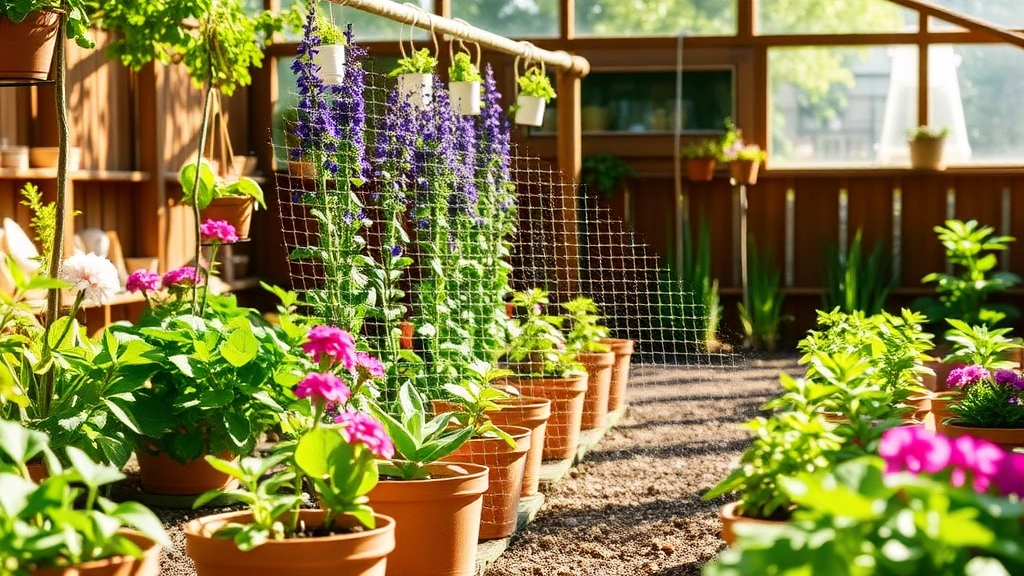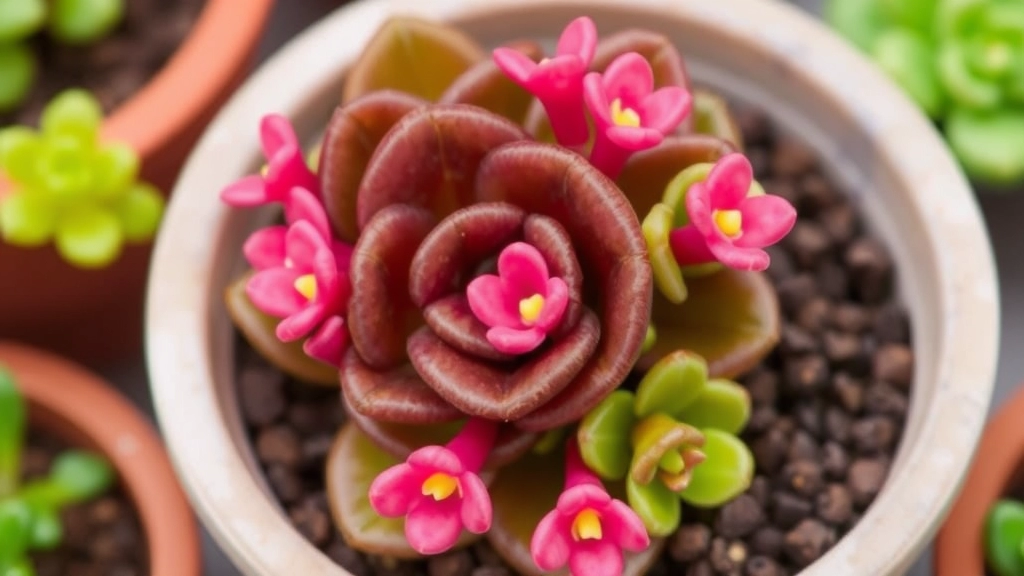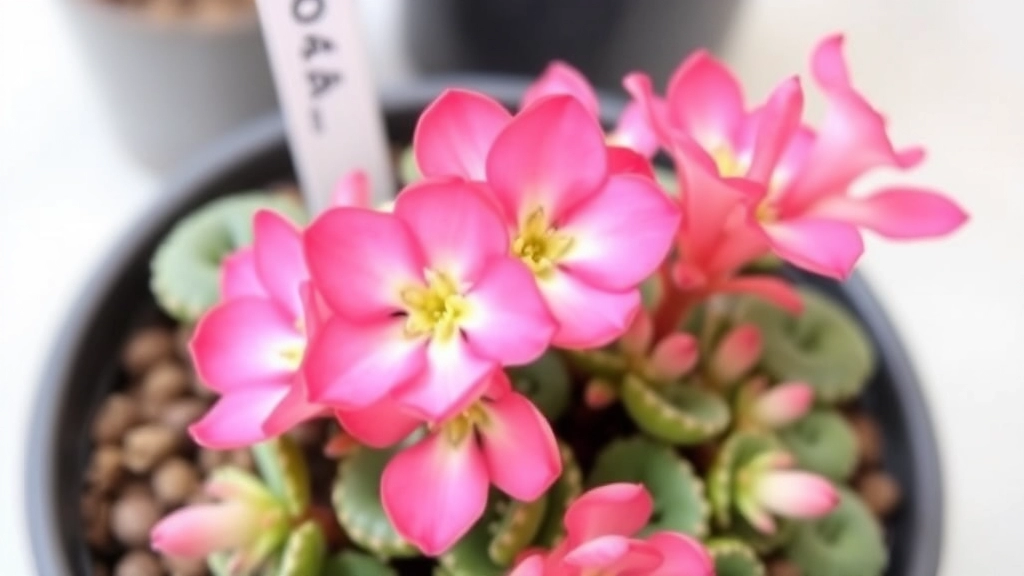Caring for Kalanchoe Tubiflora Maternity Plant
If you’re looking to care for a Kalanchoe Tubiflora Maternity Plant, also known as the Mother of Millions or Chandelier Plant, you’ve come to the right place. This unique plant is renowned for its ability to self-propagate, making it both fascinating and a bit of a challenge to manage. With the right care, you can enjoy its striking appearance without letting it take over your garden.
Ideal Growing Conditions
Kalanchoe Tubiflora thrives in bright, indirect sunlight and well-draining soil. It’s a succulent, so it doesn’t need frequent watering—just make sure the soil dries out completely between waterings. This plant is quite hardy but will benefit from occasional fertilization during its growing season. Keep an eye out for pests, and you’ll have a thriving, beautiful plant in no time.
Ideal Growing Conditions for Kalanchoe Tubiflora
Are you struggling to create the perfect environment for your Kalanchoe Tubiflora?
Understanding its ideal growing conditions is crucial for the health and vibrancy of this unique succulent.
Climate and Temperature
Kalanchoe Tubiflora thrives in warm climates.
- Optimal Temperature: Aim for a range between 20°C to 30°C during the day.
- Nighttime Temperature: It can tolerate cooler nights but should not drop below 10°C.
Light Requirements
Light is a key factor in the growth of Kalanchoe Tubiflora.
- Direct Sunlight: This plant loves bright, direct sunlight for at least six hours a day.
- Indoor Growth: If grown indoors, place it near a south-facing window to ensure it receives adequate light.
Humidity Preferences
Kalanchoe Tubiflora is not particularly picky about humidity.
- Low to Moderate Humidity: It prefers dry air, making it suitable for most indoor environments.
- Avoid High Humidity: Excess moisture can lead to rot, so ensure good air circulation.
Location Considerations
Choosing the right spot can make all the difference.
- Outdoor Planting: If planting outdoors, select a location that receives full sun.
- Indoor Potting: Use pots with drainage holes to prevent water accumulation.
For more detailed guidance, check out our Chandelier Plant Kalanchoe Tubiflora Care Guide and learn about the growth and propagation of this fascinating plant.
Watering and Sunlight Requirements

So, you’ve got your Kalanchoe Tubiflora, and you’re wondering how to keep it thriving, right?
First up, let’s chat about watering. This plant is a succulent, which means it stores water in its leaves. So, overwatering is a big no-no! Here’s how to get it right:
- Check the soil: Stick your finger an inch into the soil. If it feels dry, it’s time to water.
- Water deeply: When you do water, give it a good soak until it drains out the bottom. This encourages strong root growth.
- Frequency: Generally, every 2-3 weeks is perfect, but it can vary depending on your home’s humidity and temperature.
Now, let’s shine a light on sunlight requirements. Kalanchoe loves the sun, but there’s a catch:
- Bright, indirect light: It thrives in bright, indirect sunlight. A south-facing window is ideal.
- Avoid harsh midday sun: Too much direct sunlight can scorch those lovely leaves. Aim for morning sun and some afternoon shade.
- Signs of too little light: If your plant starts becoming leggy or the leaves turn yellow, it’s time to move it closer to the light source.
Keeping these watering and sunlight tips in mind will set your Kalanchoe Tubiflora up for success.
Best Soil Mix and Fertilization Techniques
As we delve into the specifics of caring for Kalanchoe Tubiflora, understanding the right soil mix and fertilization techniques is essential for promoting healthy growth.
Ideal Soil Mix
The foundation of a thriving Kalanchoe Tubiflora lies in its soil. A well-draining mix is crucial to prevent root rot and ensure the plant flourishes. Consider the following components for the best results:
- Cactus Mix: A pre-made cactus or succulent soil mix provides excellent drainage.
- Perlite or Pumice: Adding 20-30% perlite or pumice improves aeration and drainage.
- Organic Matter: Incorporate some organic compost for nutrients, but keep it minimal to avoid water retention.
Fertilization Techniques
Fertilizing Kalanchoe Tubiflora enhances growth and flowering. However, it’s important to do this thoughtfully:
Propagation Methods for Kalanchoe Tubiflora

When it comes to propagating Kalanchoe Tubiflora, many enthusiasts often wonder about the best methods to ensure success. This succulent is not only resilient but also offers several straightforward propagation techniques that can be both rewarding and enjoyable.
Leaf Cuttings
One of the most common methods is using leaf cuttings. Here’s how to do it effectively:
- Select a Healthy Leaf: Choose a mature, healthy leaf from the parent plant.
- Cut the Leaf: Use a clean, sharp knife to remove the leaf, ensuring you cut it at the base.
- Let It Callous: Place the leaf on a dry surface for a few days to allow the cut end to callous over. This step is crucial to prevent rot.
- Plant the Leaf: Once calloused, place the leaf in a well-draining soil mix, burying the cut end slightly.
- Water Sparingly: Mist the soil lightly, ensuring it stays moist but not soggy.
Offsets
Another effective method is to propagate through offsets, which are small plants that grow at the base of the parent.
- Identify Offsets: Look for small plants emerging from the base of the main plant.
- Remove Gently: Use a clean knife to separate the offset from the parent, ensuring it has roots.
- Replant: Place the offset in its own pot with a suitable soil mix.
- Provide Care: Water lightly and place it in bright, indirect sunlight until it establishes.
Seed Propagation
For those looking to experiment further, seed propagation is an option, though it requires more patience.
- Collect Seeds: Once flowers have bloomed, collect seeds from the dried seed pods.
- Prepare Soil: Use a seed-starting mix that drains well.
- Sow Seeds: Scatter the seeds on the surface and lightly press them into the soil.
- Moisten: Mist the surface to keep it damp but not soaked.
- Provide Light: Place the tray in a warm area with indirect sunlight until germination occurs.
Managing Overgrowth and Common Pests
As we delve deeper into caring for Kalanchoe Tubiflora, it’s essential to address a common concern: managing overgrowth and dealing with pests.
Kalanchoe Tubiflora, with its vibrant leaves and striking appearance, can sometimes become a bit too enthusiastic in its growth. Here are some straightforward strategies to keep your plant in check:
- Regular Pruning:
- Trim back any leggy stems to encourage bushier growth.
- Remove any dead or yellowing leaves to maintain plant health.
- Controlling Size:
- If your Kalanchoe is getting too large, consider repotting it into a smaller container.
- This will limit root growth and help manage its overall size.
When it comes to pests, Kalanchoe Tubiflora can attract a few unwelcome guests, such as aphids and mealybugs. Here’s how to tackle them:
- Regular Inspections:
- Check the undersides of leaves for any signs of infestation.
- Natural Remedies:
- Use a mixture of water and mild soap to wash off pests.
- Neem oil is also effective against a variety of insects and is safe for your plant.
- Isolation:
- If you notice an infestation, isolate the affected plant to prevent spreading to others in your collection.
By staying vigilant and proactive, you can keep your Kalanchoe Tubiflora thriving and pest-free. For more detailed tips on caring and propagating Kalanchoe Tubiflora, check out our comprehensive guide. Additionally, if you’re dealing with specific issues like leaf problems, we have resources to help you troubleshoot and maintain the health of your plant.
FAQs on Kalanchoe Tubiflora Maternity Plant
What are the watering requirements for Kalanchoe Tubiflora?
Kalanchoe Tubiflora is a succulent, meaning it stores water in its leaves. Overwatering can be detrimental. To water properly:
- Check the soil: Stick your finger an inch into the soil. If it feels dry, it’s time to water.
- Water deeply: When you do water, give it a good soak until it drains out the bottom.
- Frequency: Generally, every 2-3 weeks is perfect, but it can vary depending on your home’s humidity and temperature.
How much sunlight does Kalanchoe Tubiflora need?
Kalanchoe Tubiflora thrives in bright, indirect sunlight. A south-facing window is ideal. However, avoid harsh midday sun as it can scorch the leaves. Morning sun and some afternoon shade are best.
What are signs that my Kalanchoe Tubiflora is not getting enough light?
If your plant starts becoming leggy or the leaves turn yellow, it’s a sign that it needs more light. Move it closer to a light source to improve its condition.
How can I propagate Kalanchoe Tubiflora?
There are several effective methods to propagate Kalanchoe Tubiflora:
Leaf Cuttings
- Select a Healthy Leaf: Choose a mature, healthy leaf from the parent plant.
- Cut the Leaf: Use a clean, sharp knife to remove the leaf, ensuring you cut it at the base.
- Let It Callous: Place the leaf on a dry surface for a few days to allow the cut end to callous over.
- Plant the Leaf: Once calloused, place the leaf in a well-draining soil mix, burying the cut end slightly.
- Water Sparingly: Mist the soil lightly, ensuring it stays moist but not soggy.
Offsets
- Identify Offsets: Look for small plants emerging from the base of the main plant.
- Remove Gently: Use a clean knife to separate the offset from the parent, ensuring it has roots.
- Replant: Place the offset in its own pot with a suitable soil mix.
- Provide Care: Water lightly and place it in bright, indirect sunlight until it establishes.
Seed Propagation
- Collect Seeds: Once flowers have bloomed, collect seeds from the dried seed pods.
- Prepare Soil: Use a seed-starting mix that drains well.
- Sow Seeds: Scatter the seeds on the surface and lightly press them into the soil.
- Moisten: Mist the surface to keep it damp but not soaked.
- Provide Light: Place the tray in a warm area with indirect sunlight until germination occurs.
What type of soil is best for Kalanchoe Tubiflora?
Kalanchoe Tubiflora thrives in well-draining soil. A cactus or succulent mix is ideal to prevent water retention, which can lead to root rot.
How can I tell if I’m overwatering my Kalanchoe Tubiflora?
Signs of overwatering include yellowing leaves, a mushy stem, and root rot. Always ensure the soil is dry before watering again to avoid these issues.
References
-
How to Grow Kalanchoe Tubiflora Indoors – The Spruce
-
Kalanchoe Plant Care – Gardening Know How
-
Kalanchoe tubiflora (Mother of Thousands) – World of Succulents
